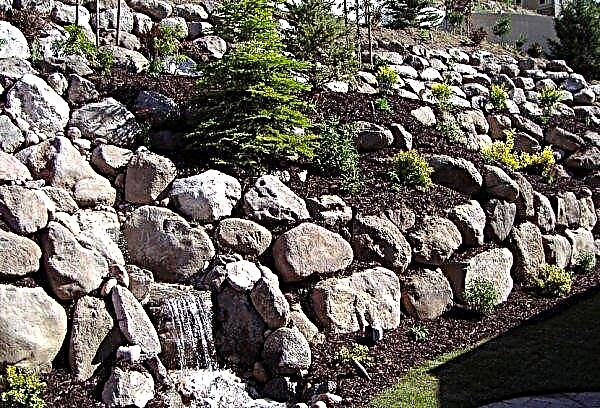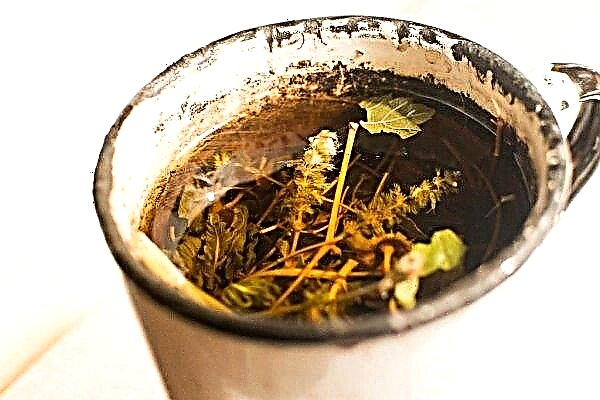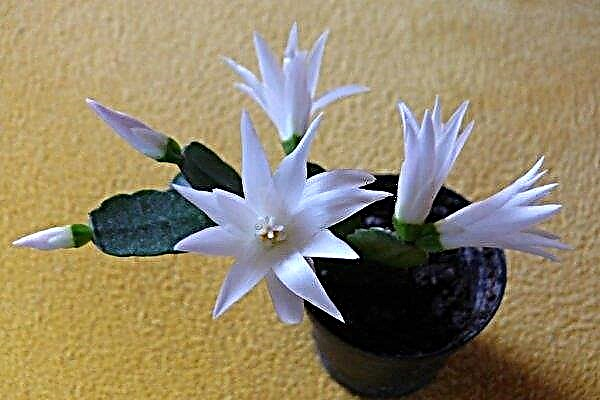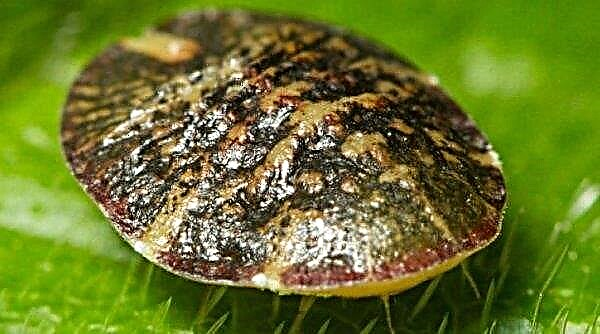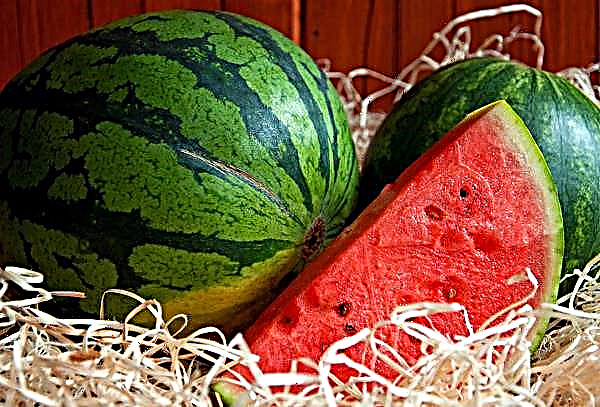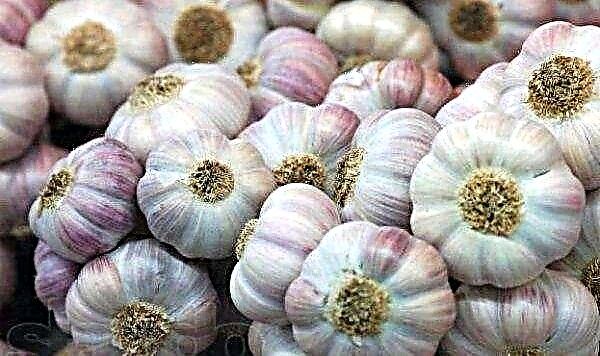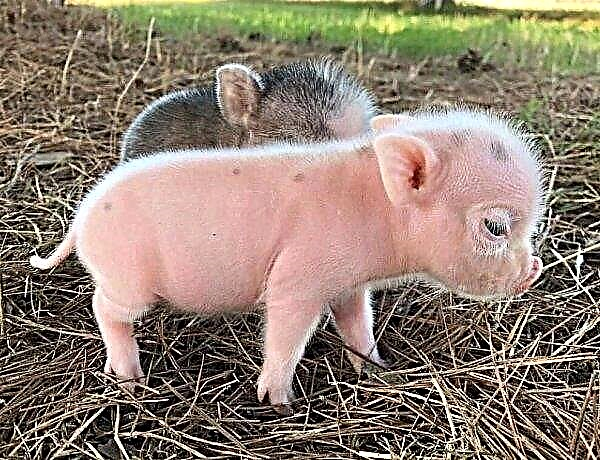Vegetable growers were very fond of the large-fruited sweet pepper of the Atlant variety. Indeed, from small garden areas, it allows you to get high yields of large, sweet vegetables with a pleasant taste. This culture is able to grow quickly and does not require special labor from the agrarian, and is also well stored and transported. The article will give a detailed description of the variety, the pros and cons, especially the cultivation and collection of fruits.
Variety selection and description
The authors of the Atlant sweet pepper variety are Russian breeders. Since 2007, culture has been in the State Register of Achievements of Selection of the Russian Federation, after which it has received regionalization in all regions of the country. The purpose of the variety is cultivation in an open area, as well as in a greenhouse, greenhouse, under a film shelter. Atlant is an early ripe species, since from the moment of seed germination to the appearance of the first vegetables only 105 to 130 days pass.

The creators of Atlant pepper give the following description of the variety:
- half-stemmed plants, sparsely branched, strong, medium-high (up to 75 cm);
- leaf plates large, dark green, slightly wrinkled;
- the fruits are large (up to 20–22 cm in longitudinal section and 6–8 cm in diameter), have a cuboid-elongated or truncated pyramidal, faceted shape;
- vegetables are smooth, glossy, green color (with technical ripeness) or bright red (fully ripened);
- within the fetal cavity there are 2-3 chambers in which a large number of seeds are located;
- average weight of 1 pepper - up to 200 g, wall thickness - up to 10 mm;
- the variety has a fairly high yield: in open areas - up to 2-3 kg / m², in the greenhouse - 3.1-3.4 kg / m² (from 1 ha - from 35 to 65 tons);
- There are excellent organoleptic properties - the pulp is juicy, moderately dense, with a sweet taste and a pleasant fresh aroma.
Advantages and disadvantages
- In addition to the fact that the described culture is universal in cultivation and has excellent organoleptic characteristics, there are other advantages:
- the variety is unpretentious;
- tolerant to adverse conditions;
- simple in agricultural technology;
- resistant to diseases and parasites affecting bell peppers;
- high percentage of antioxidants in vegetables;
- low calorie content (27 kcal per 100 g);
- beautiful large fruits with good shelf life and transportability.
Did you know? Sweet pepper, like chocolate, has antioxidant properties and also triggers the release of endorphins into the blood. But it also contains much less calories than a product from cocoa beans.
- The Atlant pepper variety has some disadvantages:
- exactingness to constant top dressing (otherwise the culture does not bring abundant crops);
- contraindications for use in certain diseases (ulcer, gastritis, ischemia, epilepsy, hypertension);
- some technical difficulties in the construction of beds and greenhouses, due to the provision of an acceptable thermal regime and extended daylight hours.
Early ripe sweet pepper varieties include:
How to grow seedlings on your own
In order to independently grow seedlings of the considered variety of pepper, you need to choose high-quality seed material, sow it in time in the right soil mixture and provide seedlings with acceptable care.
The timing
It is recommended to sow seeds of the Atlant hybrid for seedlings in the period from mid-February to the end of March.
Soil and capacity
Soil is best purchased specifically designed for peppers, but you can cook it yourself, taking in equal proportions the following components:
- peat;
- turf land;
- decayed sawdust;
- humus;
- sand;
- ash.

To sow pepper seeds for seedlings, you can take the following containers (optional):
- one common capacity (box or special tray);
- individual plastic cups (0.2 l or 0.5 l);
- peat tablets (purchased at a specialty store).
It is up to the gardener to decide which capacity to use, since each has its own pros and cons:
- plastic containers are inexpensive, because they can be made from disposable cups or plastic bottles, but they need to be drilled on the bottoms, laid out expanded clay drainage and stuffed with specially prepared soil;
- in peat tablets Good drainage of the finished nutrient composition is provided, but for planting a large number of seedlings, the gardener will have to spend more money on them.
Important! It is unacceptable to press the soil heavily, laying it in containers for germinating seeds, otherwise the seeds may not sprout.
Seed selection and preparation
Since Atlant pepper is a hybrid variety, self-harvesting of its seeds is impractical, since the yields obtained in this way will be of poor quality and with fewer fruits. Therefore, seed material must be purchased at a specialized store.

When choosing seeds in a seed shop, you need to pay attention to the following nuances:
- Regionalization of culture in accordance with the required climatic conditions. This recommendation is given on the packaging in the grade description, or it can be obtained from the seller.
- Growing place: open bed, heated, unheated greenhouse, temporary film shelter, window sill or balcony (each option has its own instructions).
- Variety or hybrid (hybrid forms from varietal differ in higher quality products with high productivity, greater resistance to diseases, high resistance to external influences).
- Ripening time (early ripe and mid-ripening varieties will make it possible to get the first crop in about 60–120 days from the moment of germination; late - in 120–150 days; very late - after 150 days).
To speed up the process of seed germination, the following manipulations will be required:
- the seeds are placed in a light pink solution of potassium permanganate for disinfection, and then washed;
- after the seeds are soaked for a day in slightly heated water mixed with any growth stimulant (this treatment will help the appearance of friendly and strong shoots);
- after the growth stimulator, the seeds are rinsed again;
- Before direct planting, the seeds are kept in a moistened gauze or cloth for a couple of days at a temperature of + 25 ° C (for better germination).
Sowing seeds
Atlant seeds are sown using the following technology:
- Before sowing in the soil with pencil, make shallow grooves 1 cm deep and a distance between them of 6-8 cm.
- If the seeds are sown in cups, then in each tank one deepening of 1 cm is made.
- Germinated seeds are laid in grooves at a distance of 2 cm from each other.
- Sprinkle the seeds on top with the same soil mixture and lightly smooth them with your hands.

Seedling Care
Further care for seedlings is as follows:
- The containers are covered with a film and put in a warm place (during the day + 23 ... + 25 ° С, at night +16 ... + 20 ° С) in good light (with illumination using a fluorescent lamp).
- The soil is periodically checked for moisture (in the morning), and if it has dried, it must be moistened with standing water with a temperature of at least + 30 ° C by spraying from a sprayer (so that the soil does not erode).
- Subject to the temperature and light conditions, the seeds will sprout in 5-14 days.
- After shoots appear, the film is removed from them, and seedlings are placed at the southern window with a day temperature of at least + 25 ... + 28 ° С and night temperature - +16 ... + 20 ° С.
- The soil should be loosened periodically, not leading to the formation of a crust (the day after watering).
- After the second pair of true leaves appears in the seedlings, they need to be dived: each seedling should be transplanted into a separate pot (if the seeds were sown in one container), so the seedlings will grow, waiting for their last transplant to an open garden bed or greenhouse.
- In April, you need to periodically take out the grown peppers for a short time on a balcony or a cool veranda for preliminary hardening, otherwise, during subsequent planting in a permanent place, the plants will experience severe stress and slow down their development for another few weeks.
- Young sprouts are supported by fertilizers, performing 2-3 dressings: the first is carried out after the second real leaf is grown with a solution of potassium nitrate (60 g of saltpeter per 20 l of water); the second - after 2 weeks with the use of the finished composition "Kemira-Lux" (40 g of the composition + 20 l of water); the third - 2-3 days before planting at permanent places with a mixture of mineral fertilizers (per 1 bucket: 2 tsp. ammonium nitrate + 3 tbsp. superphosphate + 3 tsp. potassium sulfate).
- Peppers seedlings are kept indoors until they reach 2 months of age.
Important! When diving pepper seedlings, you need to be very careful, as their young roots are very sensitive to damage.
How to transplant seedlings to a permanent place
After the pepper seedlings have received proper care and have grown enough, they must be moved on time to a suitable permanent place on the site, observing all planting rules.
The timing
40-50-day-old seedlings should be planted in open ground (approximately at the end of May). At this time, outdoor temperature indicators should be stable, without the danger of a long cold snap.
Soil should warm up not less than + 15 ° С. If the soil at this time still remains cool, in place of the beds you can install arcs and cover the bed with cellophane film.

Site selection
When choosing a place on a site for planting peppers, you need to remember the following nuances:
- The culture grows well in a bright, sheltered from the north winds place.
- It prefers fertile soil (it has been well fertilized since the fall). If the land on the site was not previously fertilized, when planting each plant in the spring, a mixture of ash and humus is poured into the hole.
- Culture loves well-drained soil, without stagnation of moisture near the root system. For this reason, it is unacceptable in the area with pepper to close the occurrence of groundwater.
- Good predecessors for vegetables can be melons, legumes, cabbage, beets, garlic, onions, cucumbers, carrots; the bad ones are solanaceous (eggplant, tomatoes, potatoes, physalis), as well as all varieties of pepper (it will be possible to plant a crop in the same place only after 3-4 years).
Scheme and depth of landing
Pepper Atlant should be planted as follows:
- Since the described variety has compact bushes, sometimes growing to a height of 1 m, it is recommended to plant them with the following planting density - 4 bushes per 1 m² or according to the scheme: the distance between the bushes is 40 cm, and in the row spacing - 60 cm.
- The depth of the holes should be slightly greater than the height of the seedling capacity (only true leaves growing from the root neck should remain on the outside).
Important! Immediately after planting, the seedlings of pepper must be shaded, which will help to avoid sunburn on the leaves and help to quickly adapt young plants to the new habitat.
How to care in the open ground
For good survival of seedlings, they need to organize the right care, consisting of an optimal schedule of irrigation, regular weeding of weeds, loosening of the soil and other necessary actions.
Watering
The described garden culture is very demanding on the moisture content of the land on the site. And yet, after planting seedlings in open ground, it is very important not to overfill the plantations, since their roots have not yet been strengthened and can begin to decay.

Watering is carried out according to the following technology:
- In the first days of life of young plantings in the open ground, it is necessary to monitor their condition every day and gradually moisten the soil around the stems, pouring 100-150 ml of water heated to + 30 ° C under each plant.
- For the first time, plants are fully watered a week after planting in an open garden bed.
- In the future, it is important to remember that if the plants do not have enough moisture, the ovary will fall off them.
- Pepper bushes will respond well to irrigation with warm water (+ 25 ... + 30 ° С). If you water the plantations with colder water, then the plants will be delayed in development.
- Watering the pepper is carried out once or twice a week, pouring water under the root of the plants.
Soil care
In order for pepper seedlings to take off quickly and develop well, it is necessary to organize proper soil care around the bushes:
- Periodically (after watering), with caution, to loosen the soil at the roots of plants: with the help of such surface loosening, an additional supply of oxygen to the roots is provided, which will help the plantations undergo adaptation more quickly.
- It is very important to weed in a timely manner, which, growing, can pick up nutrients necessary for peppers from the soil and drown out young plantings.
- Mulching is necessary, which will help preserve soil moisture, prevent weeds from growing, and prevent soil erosion and its overheating.

Pinching the top and garter bushes
After the young plantings of peppers have passed the first adaptation to environmental conditions, they must be subjected to the formation of two shoots. This is done by pinching the main stem and eliminating unnecessary shoots.
Also, for tall bushes, tying to supports is necessary, since during fruiting, when the fruits are poured, the bushes can break off under their weight.
Did you know? In the history of ancient Rome, a case was described when the inhabitants of the city paid off the militant Huns with a tribute containing more than one ton of sweet pepper, since in those days these fruits were of great material value.
Fertilizer application
After young bushes of Atlant pepper pepper take root, it is recommended to add nutritional compounds in order to grow a crop of large fruits.

There is the following schedule for timely top dressing:
- First fertilization carried out during flowering using a warm solution of chicken droppings or manure (before applying it is necessary to water the bushes so that the root system does not get burns).
- Second - during the formation of the ovaries (the soil around the bushes is sprinkled with ash at the rate of 250 ml per 1 m²).
- In the future, plants are fed 1 time in 3 weeks.
Harvesting
In late June - early July, you can already start harvesting peppers.
Harvested and stored, guided by the following rules:
- Peppers Atlant can be collected without wearing special gloves.
- Fruits can be picked once a week (with technical ripeness, when they acquire an emerald color).
- The biological ripeness of the fruit is considered when a bright red or burgundy color appears.
- During the warm season, 4-5 cleanings are allowed.
- Before frosts make the last cleaning.
- For transportation or long storage, peppers are removed along with the stem.
- Pepper can tolerate lengthy transportations, having an excellent presentation.
- For home use, peppers are stored separately from other vegetables (up to one and a half months) in cold rooms with a temperature of +8 ... + 10 ° C and low humidity (up to 40%), or in the refrigerator, in vegetable trays.
Pepper Atlant has several uses for food.
It can be:
- apply in the preparation of fresh salads;
- use in cooking hot dishes;
- dry;
- preserve whole;
- harvest chopped in the composition of canned vegetables;
- salt for subsequent stuffing;
- freeze.


